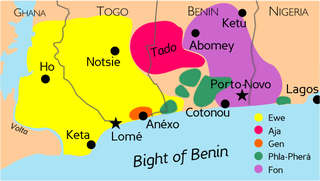Related Research Articles
Tone is the use of pitch in language to distinguish lexical or grammatical meaning—that is, to distinguish or to inflect words. All oral languages use pitch to express emotional and other para-linguistic information and to convey emphasis, contrast and other such features in what is called intonation, but not all languages use tones to distinguish words or their inflections, analogously to consonants and vowels. Languages that have this feature are called tonal languages; the distinctive tone patterns of such a language are sometimes called tonemes, by analogy with phoneme. Tonal languages are common in East and Southeast Asia, Africa, the Americas and the Pacific.

Fon is the language of the Fon people. It belongs to the Gbe group within the larger Atlantic–Congo family. It is primarily spoken in Benin, as well as in Nigeria, Togo, Ghana and Gabon, by approximately 2.28 million speakers. Like the other Gbe languages, Fon is an isolating language with a SVO basic word order.

The Tivoid languages are a branch of the Southern Bantoid languages spoken in parts of Nigeria and Cameroon. The subfamily takes its name after Tiv, the most spoken language in the group.
Southern Qiang is a Sino-Tibetan language of the Qiangic branch spoken by approximately 81,300 people along the Minjiang river in Sichuan Province, China.
The Lakes Plain languages are a family of Papuan languages, spoken in the Lakes Plain of Indonesian New Guinea. They are notable for being heavily tonal and for their lack of nasal consonants.
Maninka, or more precisely Eastern Maninka, is the name of several closely related languages and dialects of the southeastern Manding subgroup of the Mande language family. It is the mother tongue of the Malinké people in Guinea, where it is spoken by 3.1 million people and is the main language in the Upper Guinea region, and in Mali, where the closely related Bambara is a national language, as well as in Liberia, Senegal, Sierra Leone and Ivory Coast, where it has no official status. It was the language of court and government during the Mali Empire.
Guruntum is a Chadic language spoken in Bauchi and Alkaleri LGAs, Bauchi State, Nigeria. In 1993 it was spoken by about 15,000 people.
Ewondo or Beti is the language of the Beti people of Cameroon. The language had 577,700 native speakers in 1982. Ewondo is a trade language. Dialects include Badjia (Bakjo), Bafeuk, Bemvele, Bane, Beti, Enoah, Evouzom, Mbida-Bani, Mvete, Mvog-Niengue, Omvang, Yabekolo (Yebekolo), Yabeka, and Yabekanga. Ewondo speakers live primarily in Cameroon's Centre Region and the northern part of the Océan division in the South Region.
Iau or Turu is a Lakes Plain language of West Papua, Indonesia, spoken by about 2,100 people, native speakers of this language are the Turu people (Iau). Most speakers are monolingual, and their number is growing. Other peoples in the western Lakes Plain area speak basic Iau. Iau is heavily tonal, with 11 tones on nouns and 19 simple and compound tones on verbs.
Maci may refer to:

Twi is a variety of the Akan language spoken in southern and central Ghana by several million people, mainly of the Akan people, the largest of the seventeen major ethnic groups in Ghana. Twi has about 4.4 million speakers.
Mbe is a language spoken by the Mbube people of the Ogoja, Cross River State region of Nigeria, numbering about 65,000 people in 2011. As the closest relative of the Ekoid family of the Southern Bantoid languages, Mbe is fairly close to the Bantu languages. It is tonal and has a typical Niger–Congo noun-class system.
Hamtai is the most populous of the Angan languages of Papua New Guinea. It is also known as Kamea, Kapau, and Watut. Dialects are Wenta, Howi, Pmasa’a, Hamtai proper, and Kaintiba. The language was unwritten until 2009.
Gbanu is a Gbaya language of the Central African Republic. The people do not consider themselves to be ethnically Gbaya.
The Ayizo languages (Ayizɔ) are Gbe languages spoken in Benin. They are Ayizo, Kotafon, and Gbesi.
Mituku is a Bantu language of the Democratic Republic of the Congo. The Mokpá dialect is distinct.
Mesaka, or Ugarə, is a Tivoid language spoken in Cameroon.
Sochiapam is a Chinantec language of Mexico. It is most similar to Tlacoatzintepec Chinantec, with which it has 66% intelligibility.
Yong (Nyong) is a Southwestern Tai language of Thailand. It is used by Tai Yong people, who are descended from Tai Lue people from Xishuangbanna, China and Kengtung, Myanmar. Ethnologue reports that Yong is phonologically similar to the Tai Lue language. Most Yong speakers are multilingual and speak Northern Thai and Standard Thai. There were 12,600 speakers as of 2000.
Yami language, also known as Tao language, is a Malayo-Polynesian and Philippine language spoken by the Tao people of Orchid Island, 46 kilometers southeast of Taiwan. It is a member of the Ivatan dialect continuum.
References
- ↑ Ceve at Ethnologue (25th ed., 2022)

- ↑ Blench, Roger (2019). An Atlas of Nigerian Languages (4th ed.). Cambridge: Kay Williamson Educational Foundation.
- ↑ "Va, Sayegh Iceve!". SIL International. 15 September 2022.
- 1 2 3 "Iceve-Maci language and alphabet". www.omniglot.com. Retrieved 2024-03-17.